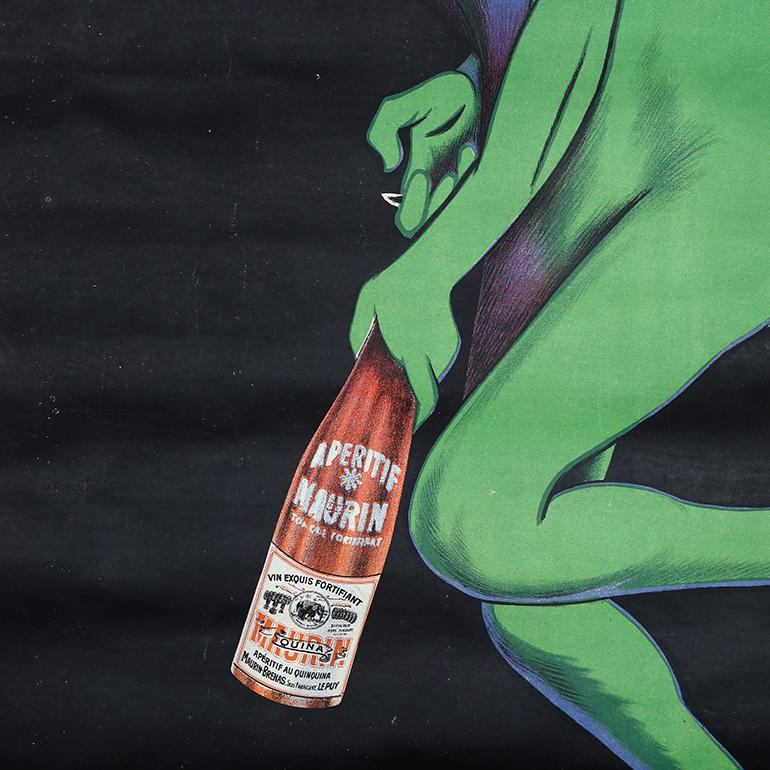Rare, original, canvas-backed ‘absinthe’ printing from 1906, by renowned artist Leonetto Cappiello, for a French alcohol called “Maurin Quina.” On this poster is depicted a mischievous, green, imp-like spirit, looking rather pleased as he de-corks his bottle. Absinthe was highly addictive and contained worm wood. The original Absinthe was said to destroy the brain and cause madness.
Absinthe was created in Neuchâtel in Switzerland in the late 18th century by the French doctor Pierre Ordinaire. It rose to great popularity as an alcoholic drink in late 19th- and early 20th-century France, particularly among Parisian artists and writers. The consumption of absinthe was opposed by social conservatives and prohibitionists, partly due to its association with bohemian culture. From Europe and the Americas, notable absinthe drinkers included Ernest Hemingway, James Joyce, Lewis Carroll, Charles Baudelaire, Paul Verlaine, Arthur Rimbaud, and Henri de Toulouse-Lautrec.
This Maurin Quina poster is without a doubt one of Cappiello’s most famous works. Unfortunately, Maurin Quina and Absinthe were both banned the year the poster was created, so it actually didn’t help sell the product until over 80 years later. In 1990, the alcohol was reintroduced to both the French and American marketplace, and Cappiello’s poster was featured as the label.
Cappiello is generally regarded as one of the greatest figures in the history of poster art, and advertising in general. He was the first artists to realize that advertisements using simple caricatures separated from complex borders and backgrounds, made brands and products much more recognizable and memorable.
More about the artist, Leonetto Cappiello:
Cappiello’s career as a poster artist began in earnest in 1900 when he began a contract with the printer Pierre Vercasson. In this period, the printers would act as an agent for artists and commission work to them. Vercasson had a print house, and his goal was to bring vibrancy and colour to the streets of Paris, he wanted the posters that he produced to stand out from the rest and attract lucrative new advertisers to his agency. Of course living in Paris, he was aware of the current art scene, and had seen many examples of Cappiello’s work, including a small number of posters already produced and in particular those for Le Frou-Frou. He knew that Cappiello had the potential to be exactly what he was looking for. The relationship commenced with the arrangement that Vercasson would find the clients and brief Cappiello on the product. It was then up to Cappiello to produce a sketch for the client for which he would receive the fee of 500 francs, a good amount at the time. Once the design had been approved by the client a full size design would be produced for the poster at a size of 1×1.4m, an old French paper standard known as the Double Grand Aigle. Cappiello would also be responsible for ensuring the successful transfer of the design onto lithographic stone ready for printing.
He was married to Suzanne Meyer Cappiello in 1901 and his brother Oreste was married to Camille, sister of the painter Alfredo Müller.
Between 1901 and 1914, he created several hundred posters in a style that revolutionised the art of poster design. Cappiello redesigned the fin-de-siècle pictures into images more relevant to the faster pace of the 20th century. During this period, Cappiello continued as a caricaturist. During World War I, Cappiello worked as an interpreter in Italy.
Dimensions:
Height: 68″
Wide: 49″








